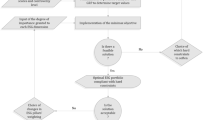Abstract
In this study, the ‘Value Score Method’ is proposed to evaluate the corporate value portfolio by using values that affect corporate value. Using a simulation analysis, this paper considers the results of six scenarios consisting of various selection criteria (5, 7, 10, 11, 12, 13 point). The performance measurements are the number of selected companies and the ‘rate of return.’ The results indicate that scenario 2 consisting of the 7-point value score displayed the highest rate of return but was identified as having significant difficulty in real world application because many management companies are faced with the problem of specific companies generating this rate of return. Thus, the scenario 3consiting 10 point value is the most realistic scenario and the good rate of return in the model. In addition, scenario 7 was set as the combination of scenario 1 consisting of the 5-point value in the down market and scenario 2 consisting of the 7-point value in the up market. Scenario 7 applied to the intersection of the reference point showed a higher cumulative return of 5,276.2% as compared with scenario 2 with an average of 190.4 companies selected.
Access this chapter
Tax calculation will be finalised at checkout
Purchases are for personal use only
Preview
Unable to display preview. Download preview PDF.
Similar content being viewed by others
References
Yi, J.H., Park, D.W.: The Stocks Profit Rate Analysis which Uses Individual ·Engine· foreigner· Knowledge Base HTS at The Bear Period The Bear Wave Period ·The Bull Period· The Bull Wave Period. Journal of the Korea Society of Computer and Information 15(1), 207–217 (2010)
Song, M.G.: Suggest points and trading behavior of individual investors in the stock market, Working Paper (2011)
Yoo, J., Jang, S.J.: Performances of Strategies of Following Foreign and Korean Institutional Investors. The Korean Journal of Financial Management 29(4), 29–60 (2012)
Seasholes, M.: Smart foreign traders in emerging markets, unpublished Harvard Business School working paper (2000)
Dvořák, T.: Do domestic investors have an information advantage? Evidence from Indonesia. The Journal of Finance 60(2), 817–839 (2005)
Lee, J.G.: The Effects of the Firm Characteristics on the Relationship between R&D Expenditures and Corporate Value in KOSDAQ. Korea Industrial Economics Association 24(1), 137–157 (2011)
Chan, S.H., Martin, J.D., Kensinger, J.W.: Corporate research and development expenditures and share value. Journal of Financial Economics 26(2), 255–276 (1990)
Doukas, J., Switzer, L.: The stock market’s valuation of R&D spending and market concentration. Journal of Economics and Business 44(2), 95–114 (1992)
Kim, B.Y., Park, H.J.: The Impact of Cash Holding on the Value of Firms. Journal of DAEHAN Association of Business Administration 26(8), 2127–2145 (2013)
Do, K.B., Kim, H.Y.: Impact of cash holdings of large-scale enterprise group on the corporate value. Journal of the Korean Data Analysis Society 15(4), 2233–2244 (2013)
Gu, S.H., Jang, S.Y.: A Simulation Study of the Investment Strategy in Stocks on Fundamental Analysis. Journal of The Korean Operations Research and Management Science Society 29(2), 53–64 (2012)
Ou, J., Penman, S.H.: Accounting Measurement, Price Earnings Ratios, and the Information Content of Security Prices. Journal of Accounting Research 27, 111–144 (1989); Current Studies on The Information Content of Accounting Earnings
Greig, A.: Fundamental Analysis and Subsequent Stock Returns. Journal of Accounting and Economics 15(2-3), 413–442 (1992)
Holthausen, R., Larcker, D.: The Prediction of stock returns using financial statement information. Journal of Accounting and Economics 15(2-3), 373–411 (1992)
Beiner, S., Drobetz, W., Schmid, F., Zimmermann, H.: Is Board Size an Independent Corporate Governance Mechanism? Journal of Kyklos 57(3), 327–356 (2004)
Black, B.S., Jang, H., Kim, W.: Does Corporate Governance Predict Firm’ Market Values? Evidence from Korea. The Journal of Law Economic & Organization 22(2), 366–413 (2006)
Tsoutsoura, M.: Corporate Social Responsibility and Financial Performance, UC Berkely Working Paper (2004)
Waddock, S.A., Graves, S.B.: The Corporate Social Performance-Financial Performance Link. Strategic Management Journal 18(4), 303–319 (1997)
Author information
Authors and Affiliations
Editor information
Editors and Affiliations
Rights and permissions
Copyright information
© 2014 Springer-Verlag Berlin Heidelberg
About this paper
Cite this paper
Gu, SH., Noh, SM., Kim, DS., Jang, SY. (2014). Enterprise Value Portfolio Selection Methodology Using Simulation. In: Tanaka, S., Hasegawa, K., Xu, R., Sakamoto, N., Turner, S.J. (eds) AsiaSim 2014. AsiaSim 2014. Communications in Computer and Information Science, vol 474. Springer, Berlin, Heidelberg. https://doi.org/10.1007/978-3-662-45289-9_30
Download citation
DOI: https://doi.org/10.1007/978-3-662-45289-9_30
Publisher Name: Springer, Berlin, Heidelberg
Print ISBN: 978-3-662-45288-2
Online ISBN: 978-3-662-45289-9
eBook Packages: Computer ScienceComputer Science (R0)




